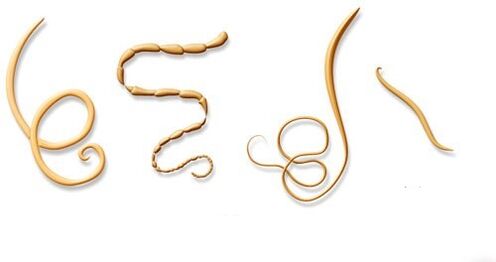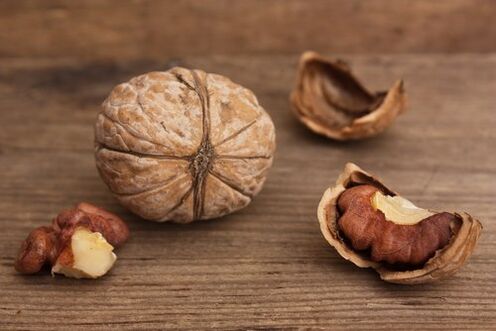Parasites are the simplest creatures that depend on humans. As for nutrition, they use cells, vitamins, substances, tissues - all for the sake of our health.
In addition, parasites are known to poison the body by releasing toxic substances. Let's take a more detailed look at the symptoms of the parasite's presence in the human body, their habitat, how to get rid of them and the precautions against their occurrence.
Harmful by parasites in the body
First of all, the functioning of organs is disrupted, namely the inflammation that occurs destroying the tissues. Often, creatures alien to us produce toxins that, over time, contribute to the poisoning of entire organisms.

The microorganisms that live in the gut feed on nutrients that go into the stomach with food. As a result, the first symptom of the presence of the parasite in the body arises: a person has a delay in development, as well as a violation of mental and physical development.
Parasites are capable of living for a long time, eggs have larvae that are very resistant to the surrounding microflora.For example, in the digestive system, in defense, they secrete substances that inactivate food-handling enzymes during metabolism.
Then the decomposition was interrupted. So, sometimes the symptoms of the presence of parasites in the human body are often similar to gastrointestinal diseases.
Common parasites
The most common types of parasites in humans are as follows:
- lice- the bites of these arthropods first irritate the skin, then turn into an eczema or pus-filled wound;
- pinworm- small white nematode, causing disease like helminthiasis;
- roundwormare parasitic worms, they are active in the intestinal tract. The length of adult males reaches 24 cm, females up to 40 cm;
- coincidental whip- ranked 3rd in frequency of disease. Infection with this parasite causes an illness - trichocephalosis. Females of this parasite are large, reaching 5, 5 cm, males are somewhat smaller - from 4 to 5 cm;
- Giardia- lives in two forms: vegetative and spore. In the first case, their vital activity takes place in the upper part of the small intestine, in the second case - in the large intestine;
- cat fluke- affects the liver and causes eye stones;
- Trichinella- nematode. Causes infestation of helminths;
- toxocara- similar to roundworm, only the diameter of the larvae is 0. 2 mm;
- enteritis- a filamentous parasite up to 2 mm long;
- nekator- toothworm larvae enter the body through the pores when walking barefoot. Their path begins with the right atrium and ends with the pulmonary artery. Breaking down the capillary walls, they enter the alveoli and from there through the respiratory tract into the pharynx.

Ways of infection
You can be infected in many different ways. Each of them is associated with the development cycle of a specific parasite. In medicine, however, there are three main sources of infection:
- Through food and water.However, contamination often occurs due to improper storage and preparation. But sometimes there is primary infection, ie when a product is contaminated with the parasite that has been under poor heat treatment;
- Via the household contact method.In this case, the infection is passed from humans or other pets;
- Through a blood-sucking insect.This link is also known as a link;
- Through communication with pets,people walking on the street.

There are larvae capable of independently entering the human body. A symptom of the presence of a parasite of this type is fungal skin disease. In this case, the larvae cling to the skin, gnaw and burrow inside the host's body.
Signs of parasitic presence
We recommend looking at the 10 key features:
- Constipation.An obstruction of digestive system organs can occur due to the large size of the worms that interfere with the normal course of peristalsis or secretion. A large amount of them closes the ducts (bile and intestines), thereby complicating bowel movements.
- Diarrhea.There are parasitic organisms that produce hormone-like substances that cause watery bowel movements.
- Bloating, gasis another factor in the presence of worms. If you do not pay attention to the periodic bloating phenomenon, the symptoms of the parasite will appear in the human body with different intensity and in a few months, sometimes all year.
- Irritable bowel syndrome.Parasites can not only cause discomfort, but also cause inflammation. As a result, this leads to a reduced rate of assimilation of substances.
- Pain in muscles and joints.In order to find the most comfortable environment, a number of microorganisms move through the body. Usually they choose muscle or joint fluid. As a result, a person experiences pain and often the symptom is caused by the effects of arthritis. Also, this symptom is considered the result of injury to muscle tissue worms.
- Allergy. Toxins often increase the eosinophil production dose. It is this substance that inflames tissues and causes allergies.
- Skin problems.Usually, worms cause only itching, eczema, and urticaria. Their presence also leads to skin ulcers, dermatitis, swelling and papillomas. When the gastrointestinal tract becomes infected, the facial skin becomes premature wrinkled, baldness appears, the heels have cracks, the nails become brittle.
- Anemia.As mentioned earlier, parasites suck up nutrients and a large amount of them cause blood loss. As a result, the body lacks iron.
- Overweight.This symptom is related to the body's defeat by a tapeworm, which means one thing: a protective response to the human body due to intoxication of products that contribute to the parasite's survival. .
- Nervous.Toxins produced by microorganisms stimulate the central nervous system. As a result, a person develops depression, increasing anxiety and stress.


Attention! Diarrhea and constipation are not only the result of malnutrition, but also the first symptoms of the parasite's presence in the human body.
How to define by appearance
According to where they live, parasites are divided into 2 categories:
- Endoparasites(worms, lamblia, echinococcus, etc. ) - people who live inside;
- Parasites, live outside (lice, fleas, bed bugs).
Can easily recognize a parasitic infestation by appearance. A rash appears on the body, accompanied by itching, redness and burning. Often small wounds (site of penetration) remain at the site of the bite.

It is more difficult to determine the intrusion of endoparasite because they live inside the body. These parasites have learned to adapt to the host's body during evolution. Studies have shown that sometimes it can take months, even decades, from infection to the onset of major symptoms.
How to diagnose the disease
Invasive diagnosis can be made with the following symptoms:
- pale skin;
- gastrointestinal problems;
- damages the upper layer of the dermis;
- aesthetic problem;
- jump weight;
- has a chronic fatigue syndrome;
- frequent headaches;
- clenched her teeth while sleeping;
- swelling of the limbs;
- pain in joints and muscles;
- disorders of the central nervous system;
- itching in the perineum and anus.
Always needs treatment
When infected, the human body is weakened, allergic, poisoned. Of course, lightning fast development of these symptoms is not observed, but lack of treatment often causes serious health problems.
Medicines from pharmacies
The most effective drugs include the following:
- for roundworm disease: piperazine adipate and pyrantel;
- for intestinal helminthiasis: mebendazole;
- cured paragonimiasis, schistosomiasis, small liver fluke,
- for echinococcus: mebendazole;
- from bovine tapeworm: praziquantel.
Popular folk remedies
In addition to garlic and pumpkin seeds, which are the three most useful products to combat parasitic infestation, nature has created 3 types of plants that can cleanse the human body when there are symptoms. The first symptom of parasites: cloves, walnuts and wormwood.
Cleanses the body from intestinal bacteria with walnuts.Pour 0. 5 liters of vodka into the green crust of 15 walnuts and place in the dark for one month. Drink within 5 days, after dissolving a drop of alcohol in 0. 1 liter of water. Then, increase the dosage to 2 -2, 5 teaspoons. and drink 2 times a day for the whole year.

Purification with wormwood.Grind the seeds of the dried plant. The reception should be initiated with a pinch. By the 15th day of admission, the dose will reach 1. 5 hours, after which, drink 0. 5 teaspoons per day. Lastly, only use the same dosage once a week.
Clean the body with clove seeds.Grind the seeds in the powder state. You need to start with 1. 5 teaspoons, gradually reducing the dosage to one teaspoon. Admission is 10 days.
Prevent infections
Once a parasite enters our body, it will go through 3 environments:
- Alkaline (oral cavity);
- Sour (stomach);
- Sealed (confidential).
If everything is in order with all barriers, then you won't be afraid of a parasite. Even if it is already in the body, it will naturally be eliminated. But when at least one barrier is breached, it signals the violation of the entire system.
First,to prevent infection, it is necessary to regularly keep hands and whole body hygiene, clean oral cavity: cure sick teeth, bleeding gums, stomatitis, go awayuncomfortable. bad smell.

Secondly, set up a drinking regimenand follow a suitable diet.
Third, get rid of bile stagnation.
And, of course, to prevent parasitic diseases, don't forget the general rules of hygiene.






































